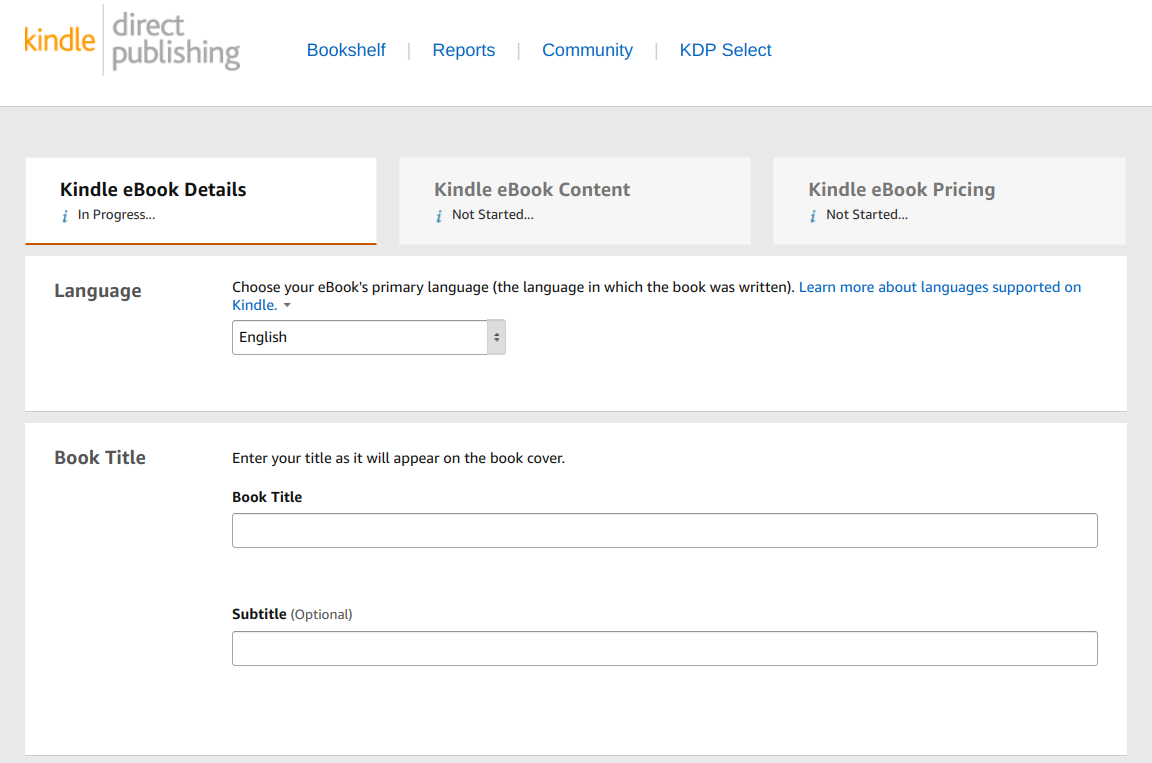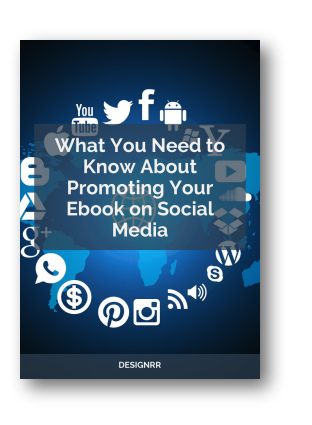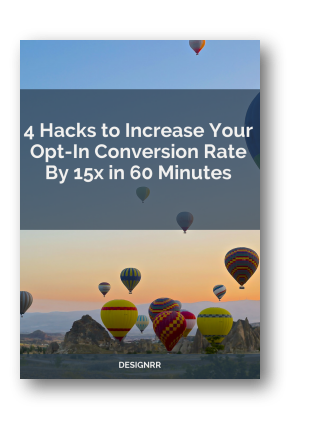Writing a book of any kind is a massive achievement. Regardless if you’re writing fiction, non-fiction, biography, a self-help manual, or a how-to guide, completing your work is a big deal.
But what happens when you finish?
What comes after you type the final word, edit the manuscript, and are ready to present your book to the world?
For many writers, traditional publishing is a non-starter. You can languish for years without hearing a single word back on the prospects of your manuscript. But how best to find your audience, even if it’s a niche community of readers.
Enter self-publishing on Amazon, the world’s largest book retailer.
As the digital retail giant got its start selling books online, Amazon knows a thing or two about helping authors find an audience. And they can help you find yours through their Kindle Direct Publishing (KDP) platform.
What is Kindle Direct Publishing (KDP)?
 While many self-publishing platforms exist, Amazon’s KDP platform is the most well-known and most widely used self-publishing tool available.
While many self-publishing platforms exist, Amazon’s KDP platform is the most well-known and most widely used self-publishing tool available.
KDP allows authors the opportunity to self-publish both eBooks and paperbacks free of charge. The platform features tools that give you near-total control of the publishing process. It does so in an easy-to-navigate user interface that removes much of the guesswork from book publishing.
You can create a product page for each of your books and increase a book’s availability with minimal time and effort. You also retain full rights to each book you publish on KDP.
 The types of books you can self publish through KDP include:
The types of books you can self publish through KDP include:
- Book Series
- Business and Investing
- Children’s Books
- Comics and Graphic Novels
- Cookbooks
- Education and Textbooks
- Literature and Fiction (including journals, novels, and poetry)
- Mystery, Thriller, and Suspense
- Non-Fiction
- Romance
- Science Fiction and Fantasy
- Teens and Young Adult
Additional formats and genres are available.
What Are The Benefits Of Self-Publishing On Amazon?
 Prior to the Amazon era, it was really hard for someone new and unknown to get a book published. You would have to pass through gatekeeper upon gatekeeper to get your work noticed, let alone ever published.
Prior to the Amazon era, it was really hard for someone new and unknown to get a book published. You would have to pass through gatekeeper upon gatekeeper to get your work noticed, let alone ever published.
Amazon has removed those barriers, circumventing the gatekeepers to allow authors and readers to connect directly.
Of course, when self-publishing, authors perform the heavy lifting of marketing their books themselves. But at least KDP allows you a platform to have your work discovered.
In addition, KDP makes self-publishing seamless and straightforward. New and established authors come to the platform on equal footing and with relatively little experience can quickly have a book live and ready for readers to purchase and download. If you run into a snag, KDP features an extensive list of help features to ensure your self-publishing is as easy as possible.
Beyond getting a book published without facing any barriers, KDP offers an incredibly economical path to publishing your work. We’ll get into specific costs in the next section (hint: there are no direct fees for publishing on KDP). For struggling authors trying to connect with a readership, few options present a better, cheaper solution than KDP.
Finally, KDP benefits those who want flexibility with publishing. Do you want to publish only digital content? KDP allows you to do just that. Want to publish paperback books? You can do that too. Or you can opt for both and reach your target audience through multiple channels.
How Much Does It Cost and What Are The Profits?
 As we mentioned above, publishing your book on KDP is free. There are no fees for setting up an account and no fees for posting your book.
As we mentioned above, publishing your book on KDP is free. There are no fees for setting up an account and no fees for posting your book.
However, as one might expect, KDP does take a cut of the proceeds from every book you sell. The commission is processed at the point of sale and assessed via two different royalty plans for eBooks and a single royalty plan for paperback publishing.
For digital publishing, the options include:
- 35% royalty: KDP commission is 65% for books priced under $2.99 or above $9.99
- 70% royalty: KDP commission is 30% for books priced between $2.99 and $9.99
You will also be responsible for a value-added tax or VAT, which over 150 countries charge. As the U.S. does not currently have VAT, your domestic sales are not subject to this added expense. For all foreign sales, you’ll need to apply these formulas:
- Your royalty = 35% royalty rate x (list price – applicable VAT)
- Your royalty = 70% royalty rate x (list price – applicable VAT – delivery costs)
For paperback royalties, you’ll need to account for various printing fees that KDP applies to print and ship your book. At its most basic, though, the paperback royalty plan is as follows:
60% royalty: (list price x 60%) – printing costs
KDP allows you flexibility in pricing. However, depending on the royalty plan you select, you may be locked into a specific price structure.
So no, KDP does not charge you a direct fee for listing and self-publishing through their platform. Their commission ultimately covers the costs of providing you the platform on which to publish.
A final note regarding royalty payment – KDP pays its authors monthly but 60 days after the point of sale. For example, if you earn $500 in royalties in January, you receive payment for those specific royalties in March. $500 in royalties in February payout in April.
8 Steps to Self-Publish Your Book on Amazon
Now let’s jump into the world of self-publishing with KDP, including how to set up your account, crafting the right title and description, select the proper keywords for your book, uploading your manuscript and cover, and pricing your book to sell.
1. Create Your Kindle Direct Publishing Account
To publish your work on KDP, you’ll first require an account. Head to kdp.amazon.com and select “Sign In” if you already have an Amazon account or “Sign Up” if you don’t.
As a first-time KDP user, accept the “Terms of Use,” after which your Author dashboard will appear.
2. Choose a Title and Subtitle
 As a first-time user, select the “Kindle eBook” option to create a new Kindle book listing.
As a first-time user, select the “Kindle eBook” option to create a new Kindle book listing.
Enter your book’s title and subtitle in the appropriate box.
Next, select the language you want your book published in. Additional options include a series number (if part of a series of books) or an edition number if the book is an updated version of a previously published book.
Now, enter your author name (if you’re writing under a pseudonym, use it here) and any contributors you had when completing the book. This may include co-authors, editors, photographers, illustrators, or any other collaborators who aided in helping you complete the book.
3. Create a Compelling Book Description
 A compelling description helps your book stand apart from others in its genre. It’s one of the first things that readers see when searching for books on Amazon. It’s often one of the central factors in whether or not they purchase a book.
A compelling description helps your book stand apart from others in its genre. It’s one of the first things that readers see when searching for books on Amazon. It’s often one of the central factors in whether or not they purchase a book.
Effectively, your KDP book description is the digital inside flap or back cover of your book. So make it count.
Amazon allows a description of up to 4,000 characters – roughly 700 words – and you should spend as much time as necessary writing your book’s pitch to your audience.
Craft a compelling description of what your book is about, one that entices the reader to want to know and read more.
Tips for writing a great description that hooks people:
- Use simple language
- While you’re allowed 4,000 characters (roughly 700 words), ensure your description falls in the 150 to 300 words range – suitable to lure readers in but short enough to read through quickly
- Provide enough compelling detail, so readers know what your book is about, featuring only the books overarching plot or theme
- Utilize words that a reader would use to search for the type of book you’ve written
- Format your description that it’s easy to read, including bold or italic fonts, bulleted lists, and paragraph breaks; avoid walls of text that are difficult to decipher
- To better understand what is involved in writing a great description, look at the bestselling books in your category and takes cues from their copy
Next, define the publishing rights – if you wrote the book, they’re yours – by selecting “I own the copyright.”
4. Select the Amazon Keywords for Your Book
 Keywords are a critical factor in ensuring readers find your book on Amazon. Use the right keywords, and your book’s searchability dramatically increases. Use the wrong words, and your book will sit idly on a dusty digital shelf.
Keywords are a critical factor in ensuring readers find your book on Amazon. Use the right keywords, and your book’s searchability dramatically increases. Use the wrong words, and your book will sit idly on a dusty digital shelf.
If you want your book to prove successful, pay close attention to your keyword selection. Think about your book’s subject matter and select those keywords representing its themes and ideas and are words readers will use to find it.
Avoid generic keywords and those already covered by your metadata. Focus on the setting, character types or roles, or story tone, or overarching themes.
For example, keywords for one of the Harry Potter books might include “YA,” “wizard,” “teen protagonist,” “coming of age,” or “modern-day Britain.”
Tips for selecting the right keywords
- Use keyword phrases that make sense, terms like “YA dystopian fantasy” are used more often than “fantasy dystopian YA.”
- Test out your keywords by searching them on Amazon before publishing
- Avoid misspelled keywords or those that use subjective, time-sensitive or common terms
You can use up to seven keywords or keyword phrases
One helpful tool for choosing keywords to include in both your title and keywords section is Ahrefs. It shows you the search volume for specific keywords on Amazon. You want to make sure that there is sufficient search volume on the keywords you include in your title and the keywords section.
For example, if you search “books like harry potter”, that has a monthly search volume of 200.
 If you search for “paleo diet”, that has a global search volume of 3,400/month and 1,800/month in the United States.
If you search for “paleo diet”, that has a global search volume of 3,400/month and 1,800/month in the United States.
 Take some time to find keywords that have a fair monthly search volume and then use them appropriately in your title, description, and keywords section.
Take some time to find keywords that have a fair monthly search volume and then use them appropriately in your title, description, and keywords section.
5. Choose the Appropriate Amazon Categories
 Categories help steer readers towards the type of books they’re seeking. It also directs your book’s placement with Amazon’s digital bookstore – where your audience will find it and the other books (many times competing books) you’ll share space with.
Categories help steer readers towards the type of books they’re seeking. It also directs your book’s placement with Amazon’s digital bookstore – where your audience will find it and the other books (many times competing books) you’ll share space with.
Especially if your book crosses genres, think about which categories your book best fits and where it will attract its target audience. KDP allows you to select two categories based on the Book Industry Standards and Communications (BISAC) code.
After selecting your two BISAC categories, you’ll then enter your book’s readership age. You don’t need to worry about this option unless your book is for young readers, be it children, teens, or young adults.
If you intend your book for a younger audience, you need to select Juvenile as one of your BISAC categories and then enter the appropriate age range.
Next, choose whether you want to immediately publish your book or set up a pre-order.
The pre-order option allows you an opportunity to promote your book ahead of its release date. For this to prove effective, you will need to develop a marketing strategy around your book’s release date.
KDP only allows this option on eBooks, and you can edit or update your manuscript until 72 hours before your book’s release date.
6. Upload Your Manuscript
 Once you’ve completed filling out the details on your book, it’s time to start uploading your book’s content files. First among these is your manuscript.
Once you’ve completed filling out the details on your book, it’s time to start uploading your book’s content files. First among these is your manuscript.
The most critical step here is enabling Digital Rights Management or DRM, which protects your book from unauthorized distribution. In other words, people cannot freely share or borrow your book without you being paid royalties for it.
Once you select the DRM option, it’s time to upload your manuscript. KDP supports multiple file formats, though the two most recommended are Kindle Create or Kindle Package Format (KPF) and EPUB.
KDP handles its formatting requirements a bit differently than other digital publishers. We recommend their suggested format – KPF – to ensure your eBook is formatted specifically for Fire Tablets and the Kindle App.
EPUB should be your second option as it stands as a universal eBook format compatible with almost every eReader and app.
Formatting is vitally important to your book’s overall success. Done well, your book will look great regardless of the device someone uses to read it.
Always preview your eBook before final publication. This will show how your book will appear on tablets, Kindle eReaders, and smartphones.
7. Upload Your Book Cover
 Yes, it’s a tired cliche, but an accurate cliche – people will judge your book based on its cover. This can be a challenging process for authors who prefer writing over designing.
Yes, it’s a tired cliche, but an accurate cliche – people will judge your book based on its cover. This can be a challenging process for authors who prefer writing over designing.
If you create your ebook with Designrr, creating a compelling cover is simple. Just start with one of our professional designs and customize it to match your book. It’s that simple!
After your cover is uploaded, preview your final product.
8. Price Your Book Competitively
Finally, it’s time to price your book. We’ve already touched royalties and what you stand to make from the sale of each book. As a general rule, you will earn more from the 70% royalty option.
KDP offers three options for setting list prices: based on your primary marketplace (the U.S., for example), setting a list price for each marketplace, or KDP pricing support.
We recommend the first option as it automatically converts the list price for other marketplaces.
Overall, pricing books with KDP is an imperfect science. You’ll want to price your book low enough to appeal to as broad an audience as possible while pricing high enough to maximize your profit after KDP takes their commission (or printing expenses in the case of paperback books).
To help guide your pricing strategy, research other books in your segment. Take note of which books are more popular, and their price points, and where overpricing could become a problem.
Final Thoughts
If you’ve written a book, the KDP platform makes it incredibly easy to publish it and sell it on Amazon.
It will require time, and plenty of patience, but the only thing more satisfying than writing a book, is having it published. Even better when you can say you did it yourself.




